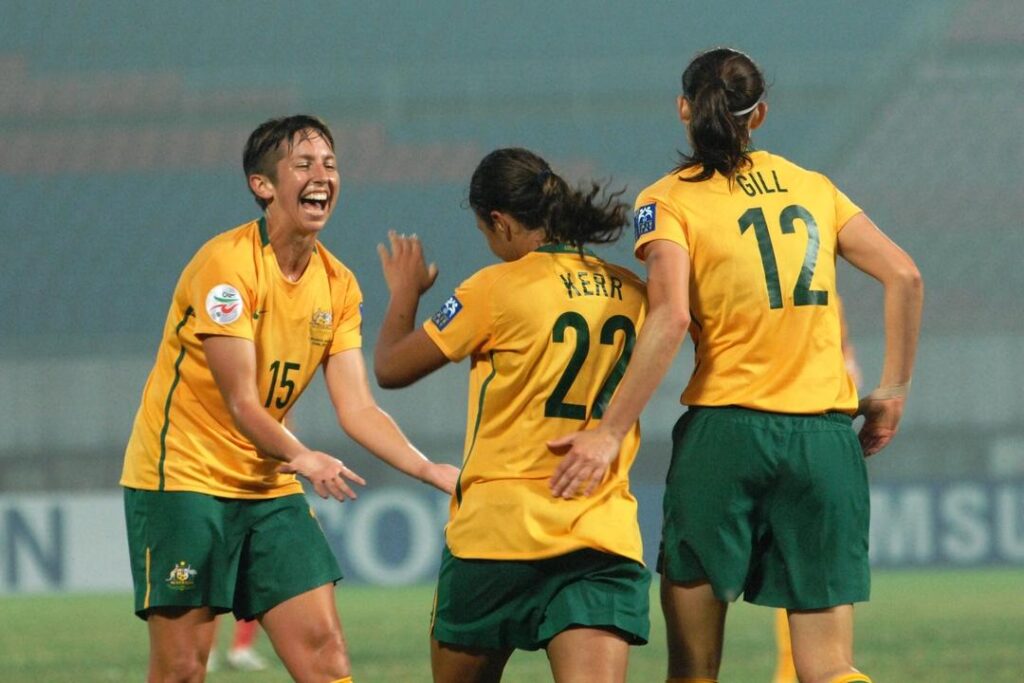By Kathryn Gill
The last time the Matildas won the Asian Cup, the only prize that the players received was a plasma screen TV.
I think it came from one of Football Australia’s sponsors, but it wasn’t much use to me because at the time I was a semi-professional footballer living a split existence between Sweden and Australia.
So I gave the TV to my parents and savoured the memories instead.
In many ways, the 2010 Asian Cup feels like a lifetime ago. Back then we were still adjusting to the Asian Football Confederation and many of the players were part-timers.
The transition from Oceania to the AFC was quite stark. We’d gone from being a dominant team in a small region to one of the contenders in a massive confederation.
There were times, in those early years, where we wondered if the Matildas would even qualify for Olympics and World Cups.
But I remember our coach, Tom Sermanni, could see the potential in the team and it felt like he was building to something.
That squad was a real melting pot of old and new. There were experienced players alongside youngsters like Sam Kerr, Kyah Simon, Lydia Williams, Tameka Yallop, Clare Polkinghorne and Aivi Luik.
We soon learned that playing in Asia was tough. We had to back up for games after 48 hours rest, and the matches kicked off at silly times of the day.
Also, we played on the same pitch as every other team, so by the end of the tournament it was hard to even kick a ball on it.
Our number one goal going into the Asian Cup was to reach the final, because that would secure our spot in the 2011 World Cup.
When we achieved that by beating Japan in the semi final, we started to believe we could win the tournament.
Two things stand out in my mind from the final against North Korea. The first is obviously that we won the game and brought home Australia’s first piece of silverware from the Asian confederation.
But I also think about how special it was for Sam Kerr to score the only goal of the final and for Kyah Simon to slot home the winner in the penalty shootout.

Sammy was 16 at the time and Kyah was 18. They both played with such youthful abandon, and I’m not sure either of them truly understood the magnitude of what they’d achieved.
There are so many defining moments in the history of Australian women’s football, but I think that Asian Cup success gave this generation a belief they could achieve something great.
Both Sammy and Kyah have since become household names and are leaders in the first generation of female players to truly experience full-time professionalism.
The Matildas’ experience of the 2022 Asian Cup, which kicks off tonight, will be very different to 2010. There’s more rest between matches, for one thing, and the quality of the stadia and hotels will be a lot better.
And if the Matildas finish in the top four, the players will for the first time receive prize money. The prize purse for the winner is around $A1.4 million.
Money won’t be at the forefront of the players minds, but we all know that it can be transformational at this critical time for the development of women’s football.
It also reinforces the importance of collective action, because unless players have a Collective Bargaining Agreement with their National Federation which stipulates how prize money should be shared, the winnings all go to the Federation to decide what the players should receive.
Two years ago, the players signed a national team CBA which lifted the Matildas minimum payments and conditions as well as their share of prize money at major tournaments.
Should the Matildas win the Asian Cup, the players will be entitled to 40 percent of any prize money – the same share as the Socceroos would receive.
Shamefully, the AFC have decided to set the prize purse of the Women’s Asian Cup at just 13 per cent of the Men’s Asian Cup.
There is a tendency to expect female players to be grateful for any advances in their wages and conditions, but the enormous discrepancy highlights the need for reform in the way the AFC thinks about the women’s game.
Of course, a prize purse of more than a million dollars is certainly better than a plasma screen TV, but there is no reason why we shouldn’t continue to advocate for equal pay and equal prize money.







